AUDI S3 2010 Owners Manual
Manufacturer: AUDI, Model Year: 2010, Model line: S3, Model: AUDI S3 2010Pages: 320, PDF Size: 75.34 MB
Page 101 of 320
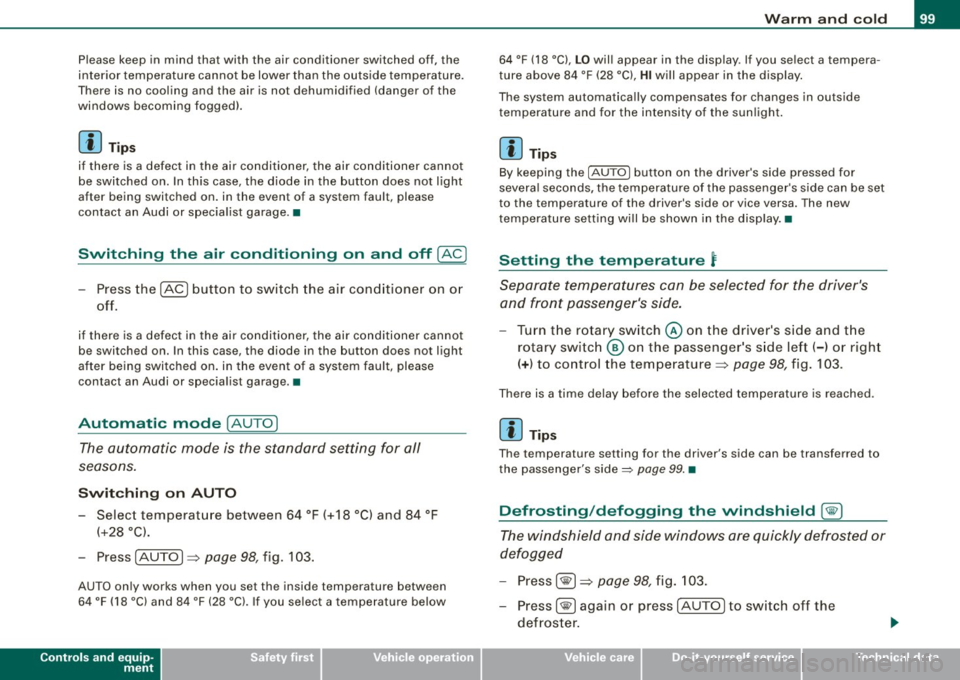
Please keep in mind that with the air conditioner switched off, the
interior temperature cannot be lower than the outside temperature.
There is no cooling and the air is not dehumidified (danger of the
windows becoming fogged).
[ i ] Tips
if there is a defect in the air conditioner, the air conditioner cannot
be switched on. In this case, the diode in the button does not light
after being switched on. in the event of a system fault, please
contact an Audi or specialist garage. •
Switching the air conditioning on and off @
-Press the [AC] button to switch the air conditioner on or
off.
if there is a defect in the air conditioner, the air conditioner cannot
be switched on. In this case, the diode in the button does not light
after being switched on . in the event of a system fault, please
contact an Audi or specialist garage. •
Automatic mode [ AUTO I
The automatic mode is the standard setting for all
seasons.
Swit ching on AUTO
- Select temperature between 64 °F (+18 °C) and 84 °F
(+28 °C) .
- Press
[AUTO I~ page 98, fig . 103.
AUTO on ly works when you set the inside temperature between
64 °F (18 °C) and 84 °F (28 °C). If you se lect a tempe rature be low
Controls and equip
ment
W arm and cold
64 °F (18 °C), LO will appear in the disp lay. If you se lect a tempera
t ure above 84 °F (28 °C),
HI will appear in the display .
The system automatica lly compensates for changes in outside
temperature and for the intensity of the sun light .
[ i ] Tip s
By keeping the [AU TO l button on the driver's side pressed for
severa l seconds, the temperature of the passenger's side can be set
to the temperature of the driver's side or vice versa. The new
t emperature setting will be shown in the disp lay. •
Setting the temperature 1
Separa te tempera tures can be selected for the driver's
and fr ont passenger's side.
- Turn the rotary sw itch © on the driver's side and the
rotary switc h@ on the passenger's s ide left( -) or right
(+ ) to control the temperature ~ page 98, fig. 103.
There is a time de lay before the selected temperature is reached.
[ i ] Tip s
The temperature setting for the driver's side can be transferred to
the passenger's side~
page 99. •
Defrosting/defogging the windshield[@)
The windshield and side windows are quickly defrosted or
defogged
- Press [®I~ page 98, fig. 103 .
- Press[@] again or press
[AUTO I to switch off the
defros ter .
I • •
Page 102 of 320
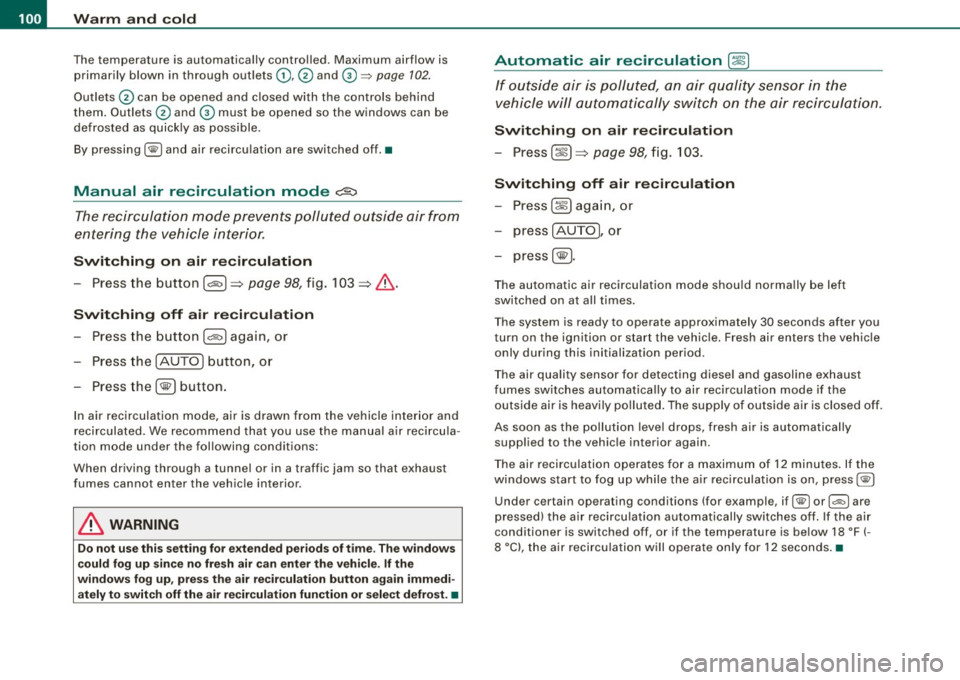
• .___w __ a _r _m _ a _n_d_ c_ o _ ld __________________________________________________ _
The temperature is auto mat ica lly contro lled. Maximum airflow is
primarily blown in through out lets G),@ and
0 => page 102 .
Outlets@ can be opened and c losed wi th the controls behind
them . Outlets @ and
0 must be opened so the windows can be
defrosted as quickly as possible.
By pressing
( lliil] and air recircula tion are switched off .•
Manual air recirculation mode ~
T he recirculation mode prevents polluted outside air from
entering the vehicle interior.
Switching on air rec ir c ulation
- Press the button [~ I=> page 98, fig. 103 => &.
Swit ching off air r ecir culation
- Press the b utton [~ I again , or
Press the [AUTO
I button, or
- Press the
l@I button.
In air recirculation mode, air is drawn from the vehicle interior and
recirculated . We recommend that you use the manual a ir reci rcu la
tion mode under th e fol lowing cond itions :
When driving through a tunnel or i n a traffic jam so that exhaust
fumes canno t en ter the vehic le interior.
& WARNING
Do not use this s etting for extended per iod s of t ime . The wind ows
c ould fog up sin ce no fre sh air can enter the vehi cle . If the
window s fog up , pre ss th e air re cir culat ion button again immed i
ately t o switch off th e air re circulation function or sel ect defro st. •
Automatic air recirculation[~ ]
If outside air is pollu te d, an air quality sens or in the
vehicle will automatically switch on the air recirculati on.
Switching on air recir culation
- Press [~ I=> page 98, fig. 103.
Switching off air re cir culation
Press@ again, or
press [AU TO
I, or
press
[ @ I.
The automatic air recirculation mode shou ld no rma lly be left
sw itched on at all times.
T he system is ready to operate approximately 30 seconds after you
t urn on the ignition or start the vehic le . Fresh air enters the vehic le
only during this ini tialization period.
The air qua lity sensor for detecting diese l and gasoline exhaust
fumes switches automatically to air recirculation mode if the outside air is h eavily po lluted . The supply of outside air is closed off.
As soon as the pollut ion leve l drops, fresh air is automatically
supplied to the vehic le interior again .
The air recirculation operates fo r a maximum of 12 minutes . If the
windows star t to fog up whi le the a ir rec irculation is on, press(@]
Under c ertain operating conditions ( for example , if
I@ ] or 1~ 1 are
pressed) the a ir rec ircu lation automatically switches o ff. If the air
cond itioner is switched off, or if the temperature is be low 18 °F ( -
8 °C), the air recircu lation wi ll opera te only for 12 sec onds. •
Page 103 of 320
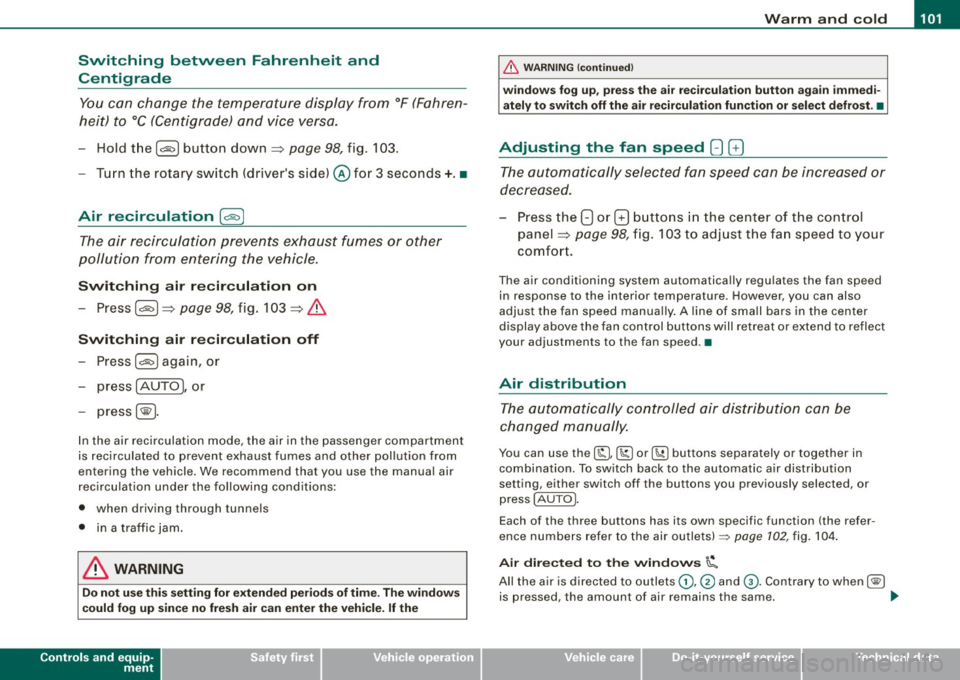
___________________________________________________ w_ a _r_m _ a_ n_d_ c_ o_ ld __ _
Switching between Fahrenheit and
Centigrade
You can change the temperature display from °F (Fahren
heit) to °C (Centigrade) and vice versa.
-Hold the [ ,;;S;)I button down => page 98, fig. 103.
- Turn the rotary switch (driver's side) @for 3 seconds+. •
Air recirculation (~ ]
The air recirculation prevents exhaust fumes or other
pollution from entering the vehicle.
Switching air recirculation on
- Press [~I=> page 98, fig. 103 => &
Switching air recirculation off
-Press~ again, or
- press
[AUTO J, or
- press[@).
In the air recirculation mode, the air in the passenger compartment
is recirculated to prevent exhaust fumes and other pollution from
entering the vehicle. We recommend that you use the manual air
recirculation under the following conditions:
• when driving through tunnels
• in a traffic jam.
& WARNING
Do not use this setting for extended periods of time . The windows
could fog up since no fresh air can enter the vehicle . If the
Controls and equip
ment
& WARNING (continued)
windows fog up, press the air recirculation button again immedi
ately to switch off the air recirculation function or select defrost. •
Adjusting the fan speed 8 G
The automatically selected fan speed can be increased or
decreased.
- Press the 8 or G buttons in the center of the control
panel=>
page 98, fig. 103 to adjust the fan speed to your
comfort.
The air conditioning system automatically regulates the fan speed
in response to the interior temperature. However, you can also
adjust the fan speed manually. A line of small bars in the center
display above the fan control buttons will retreat or extend to reflect
your adjustments to the fan speed.•
Air distribution
The automatically controlled air distribution can be
changed manually.
You can use the [1!:.), l~l or l~ l buttons separately or together in
combination. To switch back to the automatic air distribution
setting, either switch off the buttons you previously selected, or
press
[ AUTO ).
Each of the three buttons has its own specific function (the refer
ence numbers refer to the air outlets) :::>
page 102, fig. 104.
Air directed to the windows ~
All the air is directed to outlets G),@ and G). Contrary to when [@ 1
is pressed, the amount of air remains the same. .,_
I • •
Page 104 of 320
![AUDI S3 2010 Owners Manual • ..__w_ a_ r_m _ a_ n_d_ c_ o_ ld __________________________________________________ _
Air d ir ected to the dri ver/ front passe nger[~]
All the air is directed to outlets @, G) and � AUDI S3 2010 Owners Manual • ..__w_ a_ r_m _ a_ n_d_ c_ o_ ld __________________________________________________ _
Air d ir ected to the dri ver/ front passe nger[~]
All the air is directed to outlets @, G) and �](/img/6/57545/w960_57545-103.png)
• ..__w_ a_ r_m _ a_ n_d_ c_ o_ ld __________________________________________________ _
Air d ir ected to the dri ver/ front passe nger[~]
All the air is directed to outlets @, G) and © in the instrument
panel. Air also is directed through the center console in the rear.
Air dir ected to th e footw ells ~
All the air is directed to outlets © and to the outlets under the front
seats .•
Air outlets
, _ ,
,~
---- 1
'
Fig . 104 I nstrume nt pan el: a ir out let loca tio ns a nd airfl ow direc tions
T he air out lets G) and 0 on top of t he instrument pane l are
fixed . Outlets 0 and 0 can be adjusted .
Adjusting air outlets 0 and 0
- Turn the vertical thumbwheel beside the outlet to
increase, reduce or shut down t he airflow from that
outle t. - Move t
he smal l tab in the center of the o utlet lo uver side
ways and up or dow n to ad just the level an d direc tion of
airflow.
The supply of air to the outlets is controlled either automatically or manually depending on the operation mode selected . The airflow
from al l outlets can be hea ted, unheated or cooled.
The heater out lets for the rear footwells are located under the front
seats. When you select outlets©, air is also directed to the rear
footwells.
[ i ] Tips
• When defrosting/defogging the windows, air flows from outlets
G), ® and G). To defrost or defog the windows as rapidly as
possible, air out lets
G) should be opened fully with the adjuster
whee ls.
• When the air conditioner is working, cooled air wi ll flow primarily
from outlets ®·
G) and ©-To assure adequate cooling, out lets G)
and © should never be completely closed. •
Using the climate controls economically
Using the climate controls prudently can help save fuel.
When you use the air conditioner, engine power is reduced
and fuel consumption increases. To save fuel, you should
use the a ir conditioner only when necessary . Also please
note the following points:
- If you want to save fuel, sw itch off the air conditioner.
- If you are going to drive w ith the wi ndows open, switc h
off the a ir condit io n er.
~
Page 105 of 320

___________________________________________________ W_ a_ r_m _ a_ n_d_ c_ o_ ld _ __.11111
<£> For the s ake of th e envir onm ent
By reducing the amount of fue l you use, you a lso reduce the amount
of pollutants emitted into the air. •
Key coded settings
When the ignition is switched on, the air conditioner
settings are automatically assigned to the key being used.
The air conditioner settings selected are automatically stored and
assigned to the key being used. When the vehicle is started, the air
conditioner automatical ly selects the settings assigned to that key .
This way every driver will maintain his/her own personal settings and does not have to reset them manually.
[ i ] Tip s
If a different driver uses your key and changes the air conditioner
sett ings, the latest adjustments wil l erase and replace the settings
you hav e stored. •
Rear vvindovv defogger QiP
The rear window defogger clears the rear window of
condensation.
Con tro ls and eq uip
ment
F ig . 105 Sw itch for
rear window defogge r
w ith air-co nditionin g
Press the CiiP switch to switch the rear wind ow defogger
on a nd off.
The defogger works only with the engine runn ing. When the
defogger is switched on, an indicator light in the switch comes on .
The rear window defogger switches off automatically after about 20 minutes.
<£> For the sake of the environment
Turn the defogger off when the rear window is c lear . When you save
electricity, you save fuel. •
Applie s to v ehic le s: wi th di ese l e ngin e
Additional heater
-Switch the Additional h eater to AUTO .
Vehicles with diesel engines are equipped with an additional heater
to warm the interior of the vehicle more quickly. The additional
heater switches itself on and off automatically when the outside
temperature is below 50 °F (10 °C) and the engine is running ,
depending on the coolant temperature, interior temperature and
the selected temperature. •
Vehicle care I I irechnical data
Page 106 of 320
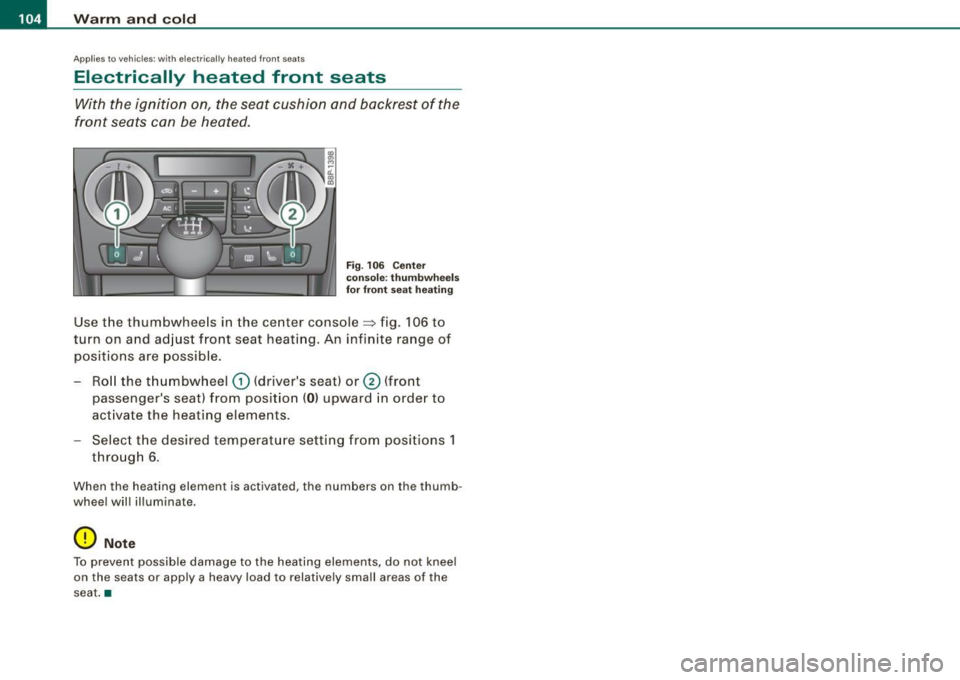
• ..__w_ a_ r_m _ a_ n_d_ c_ o_ ld __________________________________________________ _
Applies to veh ic les : wi th electr ically heated front seats
Electrically heated front seats
With the ignition on, the seat cushion and backrest of the
front seats can be heated.
Fi g. 10 6 Cente r
co nso le: thu mbwhee ls
for fr ont seat heati ng
Use th e thumbwhee ls in the center console=> fig. 106 to
turn on and ad just front seat heating. An infinite range of
positions are possible.
- Roll the thumbwheel
G) (driver's seat) or 0 (front
passenger's seat) from position
( 0 ) upward in order to
act ivate the heating elements .
- Select the desired temperature setting from positions
1
thro ugh 6.
When the heating element is activated, the numbers on the thumb
whee l wil l illuminate.
0 Note
To prevent possible damage to the hea ting elements, do not knee l
on the seats or apply a heavy load to relatively small areas of the
seat .•
Page 107 of 320
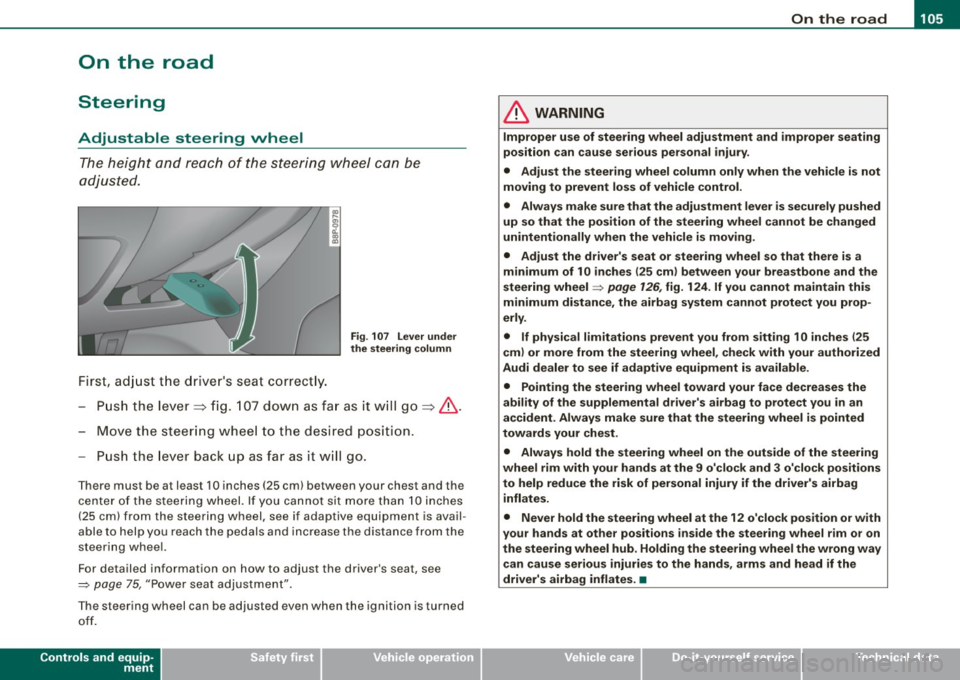
___________________________________________________ O _n_ t_h _ e_ r_ o _ a_ d __ llll
On the road
Steering
Adjustable steering wheel
The height and reach of the steering wheel can be
adjusted.
First, adjust the driver's seat correctly.
Fig. 107 Lever under
the steering column
-Push the leve r~ fig. 107 down as far as it will go~&.
- Move the steering wheel to the desired positi on.
- Push the leve r back up as fa r as it will go.
There must be at least 10 inches (25 cm) between your chest and the
center of the steering wheel. If you cannot sit more than 10 inches
(25 cm) from the steering wheel, see if adaptive equipment is avail
able to help you reach the pedals and increase the distance from the
steering wheel.
Fo r detailed information on how to adjust the driver 's seat, see
=> page
75, "Power seat adjustment".
T he steering wheel can be adjusted even when the ignition is turned
off.
Controls and equip
ment
& WARNING
Improper use of steering wheel adjustment and improper seating
position can cause serious personal injury.
• Adjust the steering wheel column only when the vehicle is not
moving to prevent loss of vehicle control.
• Always make sure that the adjustment lever is securely pushed
up so that the position of the steering wheel cannot be changed
unintentionally when the vehicle is moving .
• Adjust the driver's seat or steering wheel so that there is a
minimum of 10 inches (25 cm ) between your breastbone and the
steering wheel=> page 126 , fig. 124 . If you cannot maintain this
minimum distance, the airbag system cannot protect you prop
erly .
• If physical limitations prevent you from sitting 10 inches {25
cm ) or more from the steering wheel , check with your authorized
Audi dealer to see if adaptive equipment is available.
• Pointing the steering wheel toward your face decreases the
ability of the supplemental driver's airbag to protect you in an
accident . Always make sure that the steering wheel is pointed
towards your chest.
• Always hold the steering wheel on the outside of the steering
wheel rim with your hands at the 9 o'clock and 3 o'clock positions
to help reduce the risk of personal injury if the driver's airbag
inflates .
• Never hold the steering wheel at the 12 o'clock position or with
your hands at other positions inside the steering wheel rim or on
the steering wheel hub. Holding the steering wheel the wrong way
can cause serious injuries to the hands, arms and head if the
driver's airbag inflates. •
I • •
Page 108 of 320
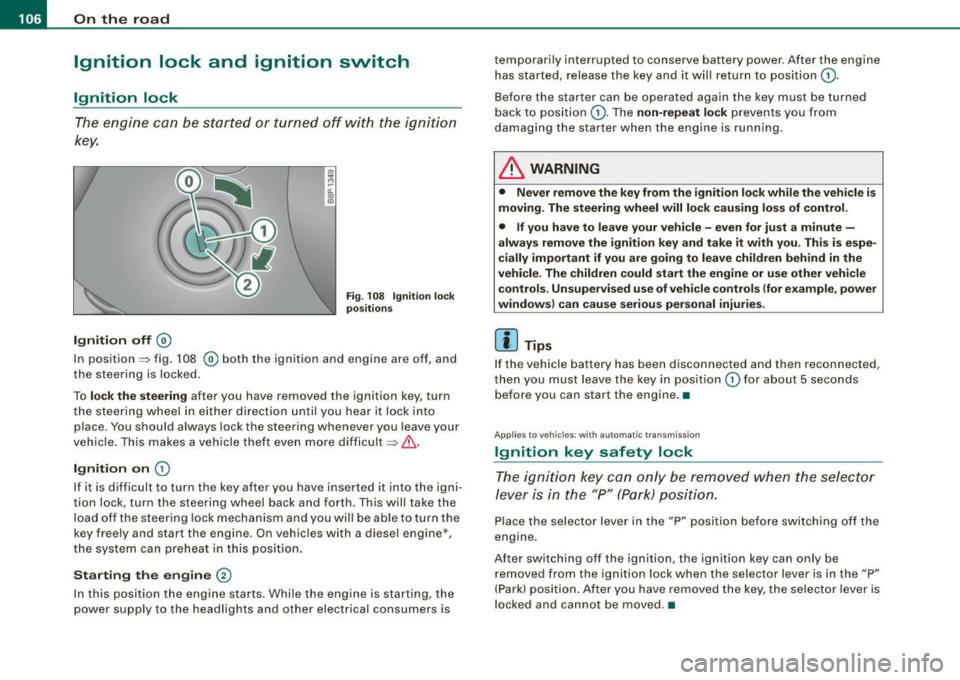
• ..__O_ n_ t_h _ e_ r_ o_ a_ d ____________________________________________________ _
Ignition lock and ignition switch
Ignition lock
The engine can be started or turned off with the ignition
key.
Ignition off ®
Fi g. 108 Ignit ion lock
p os ition s
In position => fig. 108 ® both the ignit ion and engine are off, and
the steering is locked .
To
lo ck the stee ring after you have removed the ignition key, turn
t he steering whee l in either direction until you hear it lock into
place . You should always lock the steering whenever you leave your
vehic le . This makes a vehicle theft even more difficult =>
& -
Ignition on CD
If it is difficult to turn the key after you have inserted i t into the igni
tion lock, turn the steering wheel back and forth . This will take the
load off the steering lock mechanism and you will be able to turn the
key freely and start the engine . On vehicles with a diesel engine*,
t he system can preheat in this pos ition.
St arting the engine
@
In this position the engine starts . Whi le the engine is starting, the
power supply to the headlights and other electrical consumers is temporarily interrupted to conserve battery power
. After the engine
has started, release the key and it will return to position
CD .
Before the starter can be operated again the key must be turned
back to position
CD -The non-repeat lock prevents you from
damaging the star ter when the engine is runn ing.
& WARNING
• Never remo ve the key from the ignition lo ck w hile the veh icle i s
moving. The steering whe el will lo ck caus ing lo ss of control .
• If you hav e to lea ve your vehicle -even fo r ju st a min ute -
alway s remove the ignition key and take it with you. Th is is espe
ci ally important if you are g oing to lea ve children behind in the
vehicle . The childr en co uld start the eng ine or u se other vehi cle
c on trols . Un supe rvis ed u se of veh icle c ont ro ls ( for e xamp le , po wer
windows) c an cause seriou s per sonal injuries .
[ i ] Tips
If the vehicle battery has been disconnected and then reconnected,
then you must leave the key in position
CD for about 5 seconds
before you can start the engine. •
Applies t o vehi cles : w ith autom atic trans mission
Ignition key safety lock
The ignition key can only be removed when the selector
le ver is in the "P" (Park) p osition.
Place the selector lever in the "P" posi tion be fore switching off the
engine .
After switching off the ignition, the ignition key can only be
removed from the ignition lock when the selector lever is in the "P"
(Park) position . After you have re moved the key, the selector lever is
l ocked and cannot be moved .•
Page 109 of 320
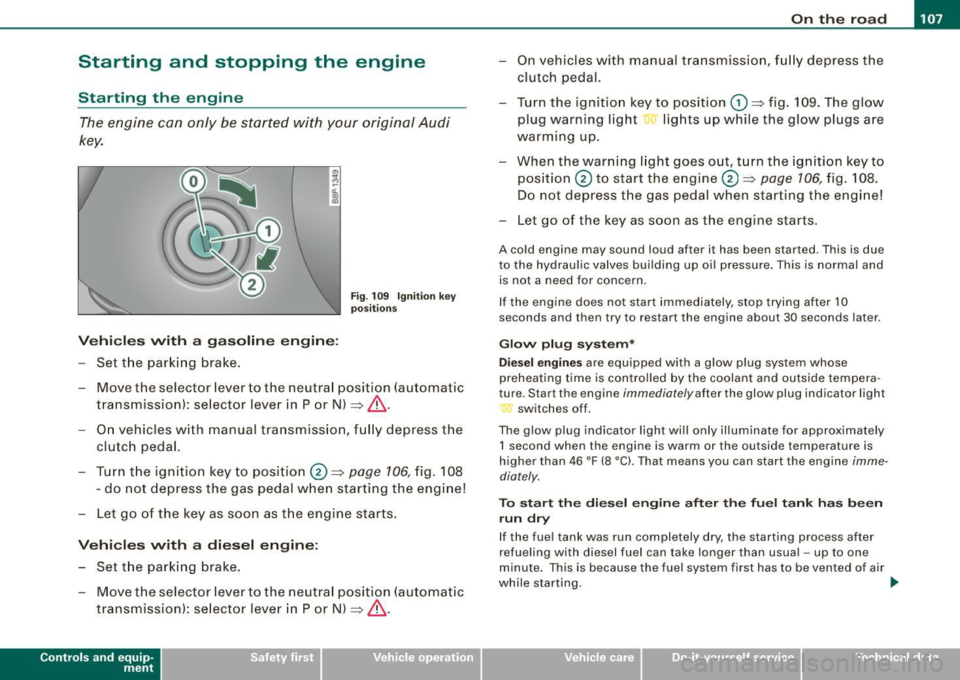
___________________________________________________ O_ n_ t_h _e_ r_o _a_ d _ ___._
Starting and stopping the engine
Starting the engine
The engine can only be st arted with your origin al Audi
key.
V ehi cle s with a gas oline engin e:
- Set the parking bra ke.
Fi g. 109 I gnit ion ke y
pos it io ns
- Move the selector lever to the neutra l position (automatic
transmission) : se lector lever in P or N) =>
&.
- On vehicles with manual transmission, fu lly depress the
c lutch pedal.
- Turn t he ign ition key to position@ =>
page 106, fig. 108
- do not depress the gas pedal when starting the engine!
- Let go of the key as s oon as the engine s tarts .
Vehicle s with a di esel engine :
- Set the parking brake .
- Move the selector lever to the neutra l position (automatic
transmission): se lector lever in P or N) =>
&.
Con tro ls and eq uip
ment
- On vehicles with manual tra nsm ission, f ully depress the
clutch pedal.
- Turn the ign ition key to position
G) => fig. 109 . The g low
plug warning light lig hts up while the glow plugs are
warming up .
- When the warning light goes out, turn the ignition ke y to
position @ to start the engine@=>
page 106, fig. 108 .
Do not depress the gas pedal when star ting the eng ine!
- Let go of the key as soon as the engine starts.
A co ld engine may sound loud after it has been started. This is due
to the hydrau lic va lves building up oi l pressure . This is normal and
is not a need for concern .
I f the engine does not start i mmediately, stop trying after 10
seconds and then try to res tart the engine about 30 seconds la ter .
Glow plug system *
D ie sel engin es
are equ ipped wi th a glow p lug system whose
preheating time is controlled by the coolant and outside tempera
ture . S tar t the engine
immediately after the glow plug indicator l ight
switches off .
The glow plug indicator light wi ll only il luminate for approximately
1 s econd when the engin e is warm or the outside temp erature is
higher than 46 °F (8 °C). That means you can start the engine
imme
diately .
To st art the di esel engin e after the fuel t ank ha s be en
run dr y
If the fue l tank was run completely dry, the starting process after
refuel ing with diesel fuel can take longer than usual -up to one
minute. This is because the fue l system first has to be vented o f air
while starting. _,.
Vehicle care I I irechnical data
Page 110 of 320

• ..__O_ n_ t_h _e _ r_o _a _ d __________________________________________________ _
& WARNING
Never start or let the engine run in a confined or enc losed area .
Exhaust fumes from the engine contain carbon monoxide , a color
le ss and odorless gas . Carbon monoxide can be fatal if inhaled .
• Never leave the engine idling unattended . An unattended
vehi cle with a runn ing engine poses a danger of personal injury or
theft.
0 Note
• Avoi d high engine speed s, fa st a ccele rati on or heavy eng ine
loads while the engi ne is sti ll cold. This cou ld damage the engine.
• The e ngi ne canno t be sta rt e d by pushing o r to w ing the vehicle.
~ For the sake of the environment
To avoid unnecessary engine wear and to re duce ex hau st emis
sions, do not let your vehicle stand and warm up. Be ready to drive
off immed iate ly afte r start ing y our veh icle. Maintain modera te
sp eed unt il the engine is completely warm. Remembe r, th e engine
performs best a t operati ng tempe ra ture .•
Stopping the engine
- Turn t he ignit ion key to position © ~ page 106 , fig. 108.
& WARNING
• Never turn off the engine until the vehicle has come to a
complete stop.
• The brake booster and servotroni c only work when the engine
is running . With the ignition turned off , you have to apply more
force when steering or braking . Since you cannot steer and stop
normally, this can lead to accidents and serious injuries .
& WARNING (continued )
• The radiator fan can continue to run for up to 10 minutes even
after you have turned off the engine and removed the ignition key .
The radiator fan can also turn on again if the engine coolant heats
up because of inten se sunlight or heat build -up in the engine
compartment .
0 Note
Do not stop the engine immediatel y after hard or extended driving.
Keep the eng ine runn ing f or ap proximate ly t wo minu tes to preven t
excessive heat build -up. •
Parking brake
Parking brake
Whe n the parking brake is s et, i t prev ent s th e v ehicl e f rom
rolli ng away un int entionally.
Setting the parking brake
Fig . 110 Center
console: Par king brake
s et
- Pull the park ing brak e lever all the way up.